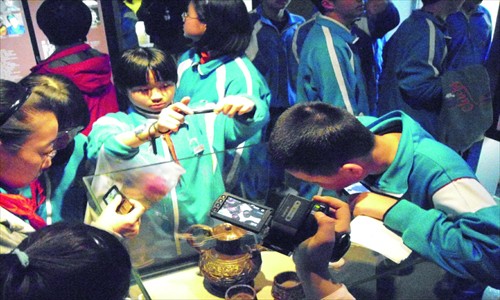
Children inspect stage props that have been well-preserved
Golden rays of light were flooding through windows onto the black wooden floor, every inch of which had been worn and torn by countless footsteps from countless actors. Visitors were informed the floor had been built in 1954 and belonged to the first stage of Capital Theater, China's first theater to be used only for drama performances.
Today the floor forms part of one of the many collections at the Beijing People's Art Theater Museum and symbolizes the development of dramatic art in modern China.
Located on the fourth floor of the Soviet-style Capital Theater, which was the main performance space for Beijing People's Art Theater, the museum is regarded as China's first professional theater museum. Founded in 2007, it spans more than 1,600 square meters and is divided into nine halls. Each hall showcases various collections, reflecting different aspects of art from the world of theater, as well as the story behind Beijing People's Art Theater.
The Founders' Hall, as its name reveals, explores those that were instrumental in the creation of the Beijing People's Art Theater. Of the many displays, it contains belongings and works of Cao Yu, one of China's most important modern dramatists and writer of Thunderstorm and Sunrise. It also has letters and manuscripts from some influential dramatists like Lao She, Jiao Juyin and Guo Moruo.
Being China's temple of dramatic art, the Capital Theater has presented a series of classic works. The Repertoire Hall contains brief introductions to these classics, including Thunderstorm, Sunrise, Peking Man and Teahouse.
It also showcases photos and posters of the theater's most influential actors, their first performances and some of the amazing costumes that they wore.
Although good actors can act without the help of tools, many feel that decent stage props add a lot to a play. The collections in the Stage Art Hall are therefore of interest. All of them have appeared in classical dramas and some are decades old. Instead of taking their beauty away, time has added more interest to the pieces.
For example, many visitors marvel in front of a glass case containing an ancient bronze goblet, which is actually made of paper and glitter paint, despite the real appearance of a metal texture.
Hu Yaxin, 14, a student from the middle school of the Haidian Teachers' College for Vocational Studies, described the experience as similar to "unrolling a scroll of dramatic art," upon stepping into the museum. "I never imagined I could encounter the art of drama so closely and through visiting the museum I really learned a lot," commented Hu.
Liu Yan, Hu's teacher, said that the museum is an "excellent place" for both students and non-students to study the arts. "This museum provides a lot of precious information about modern Chinese theater. Both children and adults will benefit from visiting it," said Liu.
Address: 22 Wangfujing Dajie, Dongcheng district
Opening hours: 10:30 am-7:30 pm (closed on Mondays)
Tel: 6524-6789 ext. 6001
Admission: free

Copyright ©1999-2011 Chinanews.com. All rights reserved.
Reproduction in whole or in part without permission is prohibited.